Growth and development
Every child is an individual. He or she grows and develops at his or her
own rate. Two children in the same family are no exception. One may walk
at 9 months, but the other may not walk until the first birthday.
Generally, however, growth and development can be fairly well predicted.
For more information, see [Growth] in the section For
Special Consideration.
The first month
The average newborn weighs from 616 to 8 pounds (3 to 3.5 kilograms) and
is anywhere from 18 to 22 inches (45 to 55 centimeters) long. In the
first three to five days,
the infant may lose up to 10 per cent of birth weight. This occurs
because more fluids are lost than are gained through feeding. There is
no need to worry. The baby’s weight is usually back up to birth weight
in one or two weeks.
The first few weeks of your baby’s life are taken up mostly by eating
and sleeping, and crying when hungry, wet, or otherwise uncomfortable.
The newborn’s breathing is erratic during sleep—at times very noisy
and fast, at times very quiet. All newborns breathe through their noses
and find mouth breathing almost impossible. This makes it possible for
them to feed and breathe at the same time, without ever having the
bottle or breast removed from their mouths.
Newborns keep their hands tightly clenched most of the time and hold
them close to their faces. When they are picked up, their arms and legs
may stiffen or make jerky movements. Their hands and chins may tremble
at times. These movements gradually disappear after the first few weeks.
At times young infants move about the crib and go from one end to the
other. While lying on their backs they may kick, and when held erect,
may make stepping motions.
We now know that even newborn infants are responsive to their
environment. They can hear and they can look at objects— especially
the human face and bright lights. They let you know when they are hungry
or wet and are comforted by being fed and changed—as well as by the
sound of their parents’ voices. Babies are born with certain reflex
actions. A noise or movement can set off flailing of the arms and legs,
quivering of the chin, and loud crying. In the first month, the ringing
of a bell can make babies stop what they are doing. If an object is put
against an infant’s palm, the baby will grip the object and then drop
it. A soft touch of the finger or the nipple of the mother’s breast is
enough to make an infant turn in that direction and start sucking.
When prone, a newborn baby can raise the head and move it from side to
side. But in general, during the first month of life, the baby has
little control of the head. The head lags when you lift the baby to a
sitting posi-
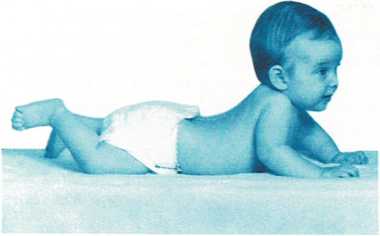
3-4 months: usually lifts chest
tion. For this reason, you should keep a hand behind the infant’s head
when you lift your baby.
Age 1 to \^ months
Between 1 and 2 months of age, infants are able to raise their heads up
above a flat surface. As babies grow, they can hold their heads up for
longer periods of time. Also between 1 and 2 months, most babies can
briefly follow a bright object or light.
By 2 months, babies usually stop crying on hearing their mothers speak,
even though wet, hungry, or uncomfortable. At about four to six weeks,
babies smile for the first time, generally in response to mother’s
voice. In the next few weeks, babies will begin smiling at all pleasant
voices, then familiar faces, and make cooing sounds in response to
familiar voices. This is the beginning of language.
At 3 months, babies’ heads still bob when they sit, but they have much
more consistent head control. When lying on their stomachs, babies 3 to
4 months old can raise their heads and chests well above the mattress
while supporting their weight on their forearms.
Three-month-old babies may spend long periods of time looking at their
hands and watching their fingers move. Babies play with their hands as
toys. Near 4 months, babies can bring their hands together in front of
them, and before long they may actively suck their thumbs.
Although at about 3 months babies still cannot reach out and grasp
objects, their arm and hand movements do increase. The hands are no
longer tight little fists. Babies hold objects that are placed in their
hands.
By 4 months, babies can hold and shake a small, toy rattle.
By the second or third month, most babies are able to focus and follow
faces and objects more consistently. They can also focus on objects they
are holding. Their eyes may cross, particularly if they stare at objects
for a long time. Do not let this concern you unless your baby’s eyes
persistently remain crossed.
When babies are about 4 or 5 months old, they will probably roll over
for the first time, usually from the belly to the back. Before very
long, they may roll over on the stomach.
At about 4 months, babies may start to laugh aloud, with a deep belly
laugh. At first the sounds of their laughter may surprise and scare them
into short periods of crying. But soon, the infants laugh in response to
almost any pleasant sound or smiling face.
At this age, babies will begin to anticipate feeding time. As soon as
they recognize the bottle, they may wave their arms and legs excitedly
and make sucking movements.
At 5 months, babies are able to pull up to a sitting position when they
are lifted by the hands, and they can sit alone for about half an hour
if they are propped up. Some more placid infants, particularly if they
are plump, do not sit alone with support until the seventh month or so.
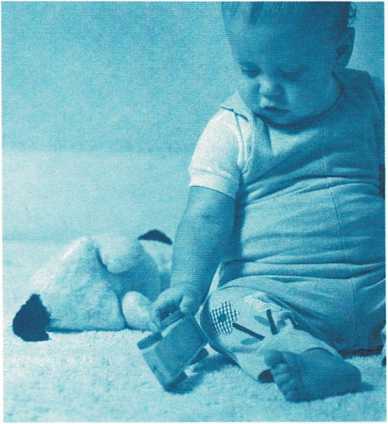
7-8 months: usually sits without support
By 7 months, most babies can get up on their hands and knees. By 8 or 9
months, most babies can pull themselves upright to a full standing
position. A baby of this age should never be left in a crib with the
sides down.
During these months, babies are busy exploring their own bodies and all
things around them. Everything seems to go into the mouth—not only the
thumb and hand, but also toys, toes, and even the ribbons on
nightshirts. As can be expected, babies also drool a lot.
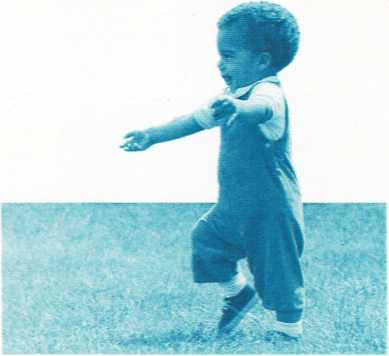
13-15 months: usually walks alone
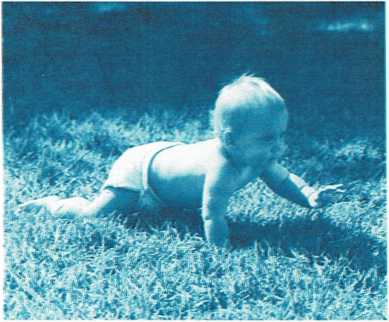
9-10 months: usually creeps
Major milestones of motor development
One of the biggest enjoyments of watching your baby grow is seeing the
first tooth come in. Preceded by weeks of drooling, and followed by more
of the same, the first tooth produces pride that is a forerunner of what
you will feel when baby takes that first step.
The first tooth generally breaks through the gums when the baby is 6 or
7 months old. But if it does not come until several months later, do not
be concerned. As you will be told over and over again, every child is an
individual. (For more information about the teeth, see [Teeth and
teething] in the Medical Guide.)
At some time in this period, usually at 6 months, babies may develop a
fear of strangers. In all likelihood, this represents an increasing
ability to tell familiar faces from unfamiliar ones. Stranger anxiety is
less likely to occur in babies who have multiple caretakers.
Age in Activity
months
1-2 Lifts head when lying on stomach
3-4 Lifts chest when lying on stomach
4-5 Reaches out and grasps
objects; Rolls over
5-6 Sits up if propped
6-7 Transfers objects hand to hand
7-8 Sits without support
8-9 Grasps small objects with thumb
and index finger
9-10 Crawls; Creeps on hands and knees; Stands with support
11-12 Walks with support of one hand 13-15 Walks alone; Climbs
onto furniture; Turns the pages of a book
16-18 Runs stiffly; Feeds self
Usually, the skills of motor development come one after another in
orderly fashion. In some instances, the achievement of one skill depends
on successful achievement of a previous one—for example, a baby learns
to take hold of an object voluntarily before learning how to pass it
from one hand to the other. Sometimes, however, children skip
milestones. For example, although most infants crawl and then creep
before walking, others may skip the crawling and creeping stages
completely. Every child is different. No two infants, even in the same
family, develop at exactly the same rate.
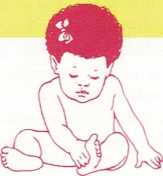

Babies love the shine, noise, and texture of pots and pans.
At 6 to 7 months of age, babies develop the ability to pass objects from
one hand to the other. Infants can grasp an object, move it over to the
opposite hand, and take hold of it with that hand.
By about 8 or 9 months of age, babies usually begin to use the thumb and
index finger for grasping small objects. And they
use both hands simultaneously—feeding themselves cookies with one hand
while banging a cup or plate with a toy held in the other hand.
Age 9 to 12 months
At this age, babies reach out into their environment, not just with the
hands but
with the whole body. They can sit, lie on the back, and then sit again.
By 9 or 10 months, infants can crawl on the stomach and creep on hands
and knees. They can support their weight by holding onto the sides of
the crib or playpen.
Most babies of this age can pull themselves up to a standing position
without any help. A mother might put her baby down in the crib or
playpen, only to find the child standing by the time she turns around.
In the beginning, however, babies may not know how to sit down again.
About this time, cruising from one piece of furniture to another becomes
an exciting event. By the end of the first year, most babies can walk
with one hand supported, and some can walk without any support at all.
By the age of 1 year, babies can “sing” to music and play pat-a-cake,
and they may enjoy looking at picture books. They can also understand
simple commands.
During this period, babies learn to do many things with their hands and
fingers— poke, point, touch, lift, twist, squeeze, pick up, and drop.
Simple items such as spoons, pots, and pans can keep children busy for
hours. Babies become quite adept at repeatedly dropping toys, utensils,
or food from high chairs and over the sides of playpens. This can be
quite upsetting, especially when cereal hits the kitchen floor or
dropped glasses shatter. Console yourself with the fact that this is all
part of babies’ normal development. They are learning that if they drop
something, it will fall. They are also learning a new way of getting
attention.
Babies use spoons more at mealtime—but less to feed themselves than to
splash the spoons in their food. They can drink from cups by the end of
the first year, although this is usually pretty messy. To save on
breakage, and for safety, you may want to use plastic cups. Remember not
to put a 1-year-old to bed with a bottle filled with milk or any sugared
drink or juice. It could lead to a severe form of caries affecting the
upper front teeth.
Age 13 to 15 months
During this period your baby will probably begin to walk alone, gaining
new independence and leading to considerable exploring.
They will climb onto and off furniture. Since babies don’t know the
difference between dangerous and safe situations, you should set limits
on this activity.
Children of 15 months get joy from dumping items out of bottles and
boxes, and may practice this skill by emptying wastebaskets and pouring
liquids out of bottles. Be certain that medicines, household cleaners,
and other poisons are out of reach. A simple chain lock keeps kitchen
closets closed, and locks for cabinet doors are also available. If one
cabinet can be filled with pots, pans, plastic jars, and other favorite
toys, let your baby open that one and play with its contents. This
should divert the baby’s attention from the locked doors. Also be
certain that there are no house plants anywhere within your baby’s
reach.
Although they are very active, babies will sit still for long periods of
time, turning the pages of magazines or picture books, or playing with
blocks and toys. They will also assist in dressing and undressing
themselves, although this “help” may lengthen the process.
At this age, children still babble as they develop a vocabulary of 10 to
20 words. However, some children of this age virtually quit using words
so that they can spend more time learning other skills. It is as though
they can concentrate on the development of only one major skill at a
time.
At about this time children also understand a number of verbal commands,
particularly “no.” Children at this age understand “no” so well that
they start using it for their own purposes. They push toys or food that
they don’t want away from them. They may not want to give up toys or
stop enjoyable games just when parents want them to. It becomes
increasingly hard to substitute one activity for another.
Age 16 to 18 months
At this age, children’s motor activity is reaching such a fine level of
control that they start to run instead of walk. In fact, it may seem
that they are on the run constantly, going from room to room with
frustrating speed. And they are now able to walk up and down stairs
while holding on to someone’s hand.
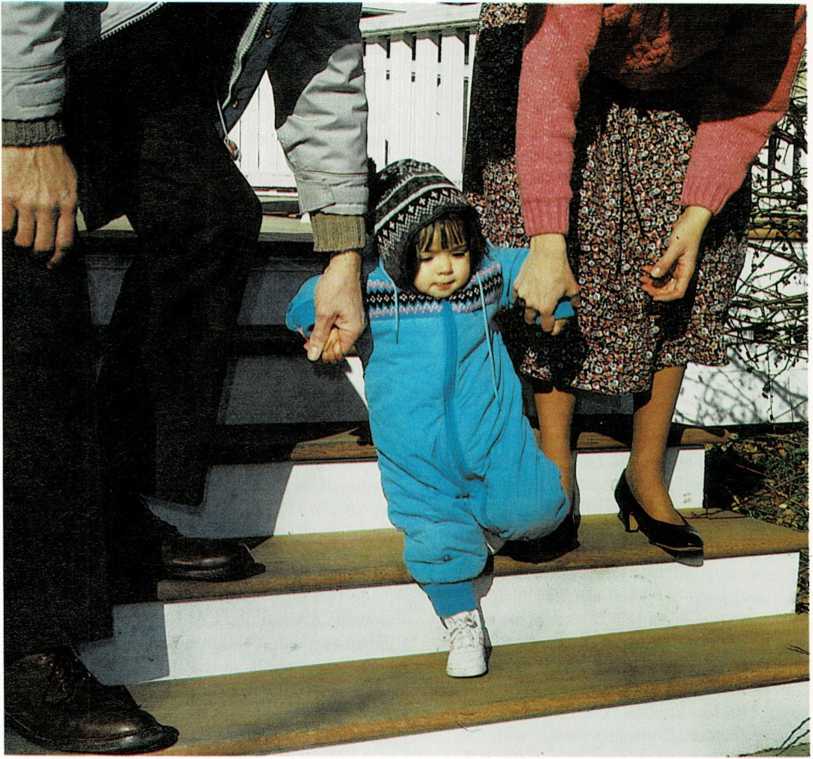
A baby about a year and a half old can walk
up and down stairs with help.
Feeding time for children at this age is somewhat neater because they
have better control of the spoon. They can now scribble with crayons on
paper and—when unsupervised— on the wall or floor. They enjoy
building towers of two or three blocks and then knocking them down. They
begin to play with push and pull toys, and often try to push or pull
them through the furniture. You may be able to determine whether your
child will be left-handed or right-handed at around 18 months, but this
trait is seldom demonstrated before the end of the second year. Any
earlier consistent preference for one hand over another should be
brought to your doctor’s attention. It could be a sign of weakness of
the opposite arm or hand.
By the time children are 18 months old, they should know the names of
many household items. They may not be able to call them by name, but
they understand what the items are and can associate the names with
pictures, as well as with the objects themselves.
Children at 16 to 18 months are a conflict between dependence and
independence. They set out on their own to explore the
environment—climbing, walking, opening doors, trying to dress
themselves, and helping to feed themselves. But they still must be
helped down from the steps they have climbed, given the proper food,
protected from accidents, and cuddled and cooed over when they scrape
their knees.
